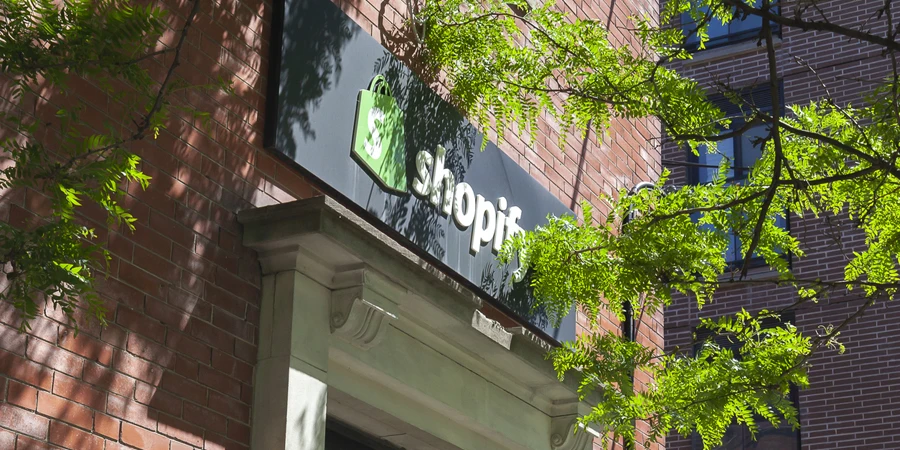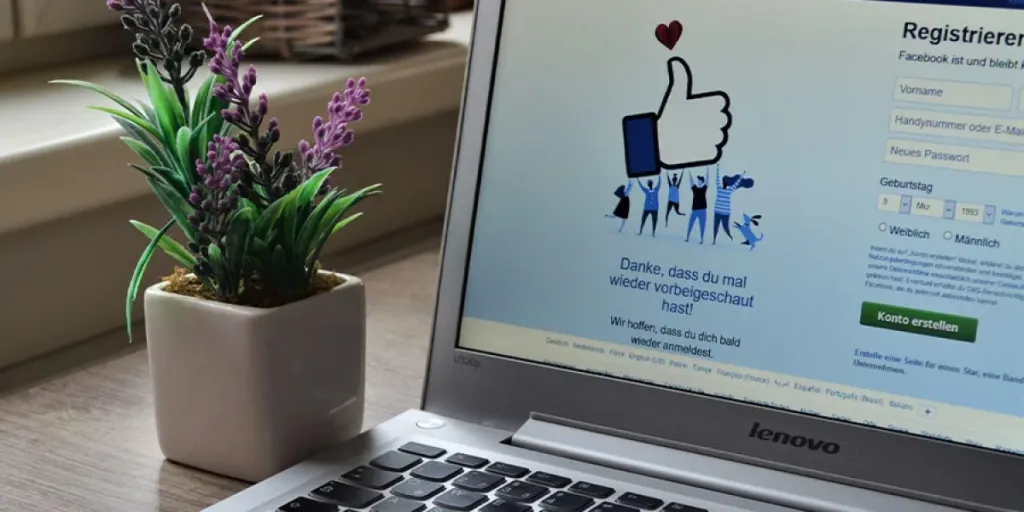Marketers often focus on attracting new leads, but retaining your current customers can be even more important. Your online marketing strategy should include methods to keep subscribers engaged with your brand. And a great winback email campaign can help you do just that.
The idea behind winning back your customers is quite simple: it’s cheaper to reactivate a customer than it is to acquire a new one. Not only that, but winback and lapsed purchase emails have a 6x lift in conversion rates compared to campaign emails.
This article will cover everything you need to know in order to develop effective winback campaigns (one of the best examples of email marketing) and reduce unsubscribes. Re-engaging even a small percentage of users is one of the most powerful ways to increase average lifetime customer value.
Table of Contents
1. What are winback emails?
2. When should I send winback emails?
3. 10 winback email examples
4. Best practices for winback emails
5. Why do subscribers stop opening emails?
6. Developing a winback email campaign
7. Conclusion
What are winback emails?
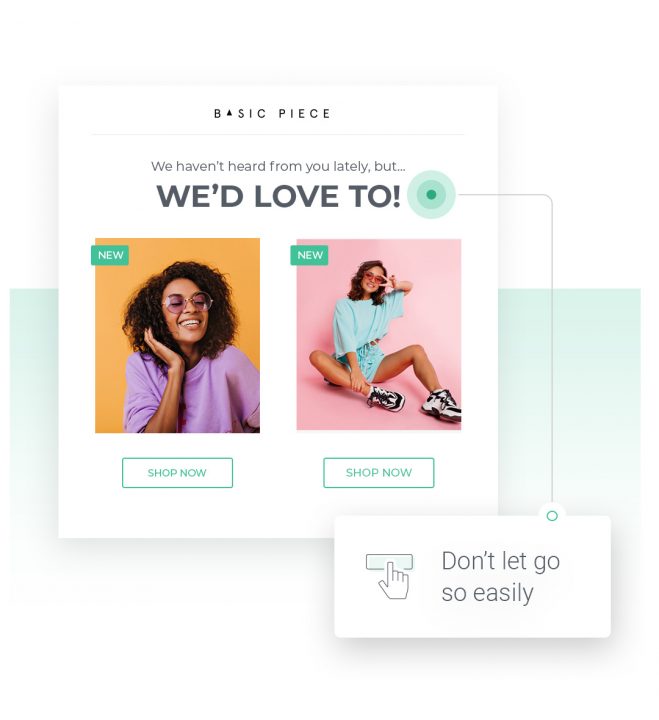
A customer winback email is a message designed to regain a subscriber’s interest after they have stopped opening or clicking through on your previous messages. Existing customers are incredibly valuable, and too many businesses let them go rather than implementing a strategy to re-engage them before it’s too late.
Here’s how to tell when your customers are inactive and need to be won back:
- 90 days of inactivity: The customer is beginning to lose interest in your brand.
- 90-120 days of inactivity: The customer is at a high risk of lapsing. You’re about to lose them.
- 120-180 days of inactivity: The customer has lapsed. They no longer interact with your brand.
An effective winback email campaign can substantially decrease your unsubscribe rate and turn lapsed readers back into loyal customers. Of course, the right tactics for your business depend on various factors, including your typical sales cycle and your audience’s unique preferences.
When should I send winback emails?
There’s no perfect definition of a lapsed customer, and the right time to target inactive users depends on your approach to sales. Understanding when to start your customer winback email series is critical for maximizing long-term engagement.
For example, you could measure subscriber engagement by monitoring opens, clicks, or purchases. If your website offers relatively affordable items that customers buy frequently, then opens or clicks might not be enough to consider someone as active. Blog owners, however, may be satisfied when readers click through to read their content.
In general, subscribers who go more than three months without engaging can be considered inactive. Six to nine months may be too long to wait as some readers will be completely disengaged by then. The longer you wait, the more time you give your audience to move on and forget about your brand.
10 winback email examples
1. SPY
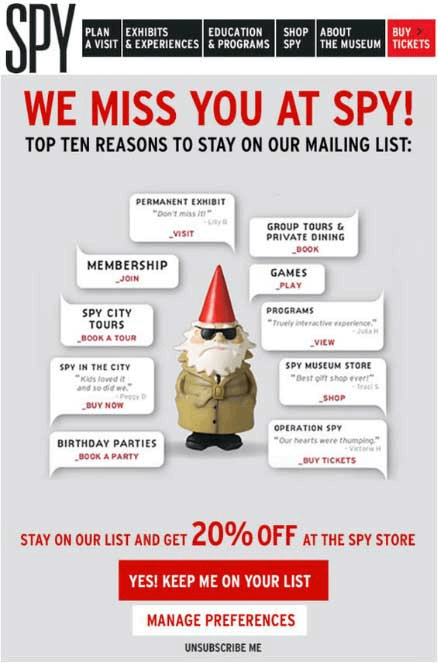
This winback email example uses a discount to incentivize users to stay on their list. Its visual design communicates a significant amount of information while making the message easy to scan. Quotes from customers give readers an additional reason to consider the offer.
Notice that the call to action includes a link to stay on the list along with one that allows users to manage their subscription preferences. While the unsubscribe option is still clearly displayed, it’s underneath the two desired actions in a much smaller font.
2. Starbucks
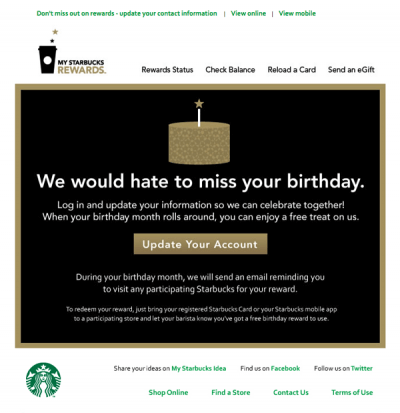
This ad from Starbucks offers a no-strings-attached gift rather than a discount on a large order. Offering something for free is a useful strategy that’s much more likely to win back users who have already disengaged.
Of course, subscribers will need to present either a Starbucks card or the mobile app to redeem their reward. Downloading the app or buying a gift card increases the chances that a customer will continue interacting with the brand and make purchases. One free item is a small price for Starbucks to pay to bring back a returning customer.
3. Sears
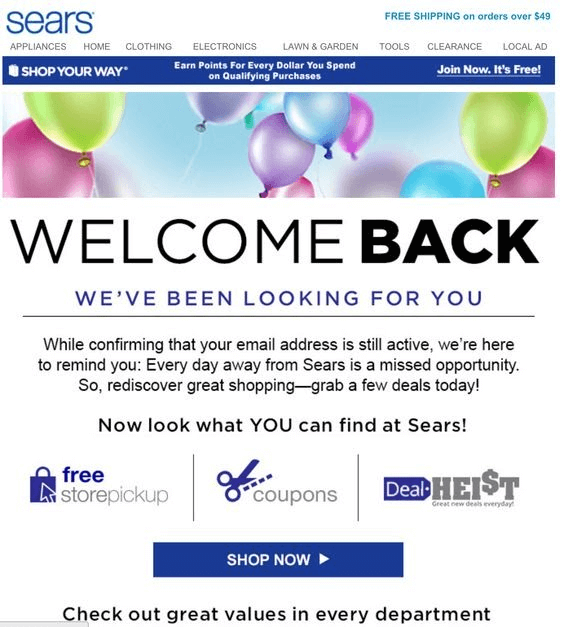
While this message doesn’t contain an exclusive offer, it still provides readers with a number of reasons to re-engage with Sears. After the welcome back text, the winback email template focuses on three new benefits that the reader may not be aware of.
On the other hand, this winback email has a relatively simple visual design compared to other examples, with almost everything in black, blue, or white. Several distracting elements at the top draw the reader’s attention away from the call to action.
4. Framebridge
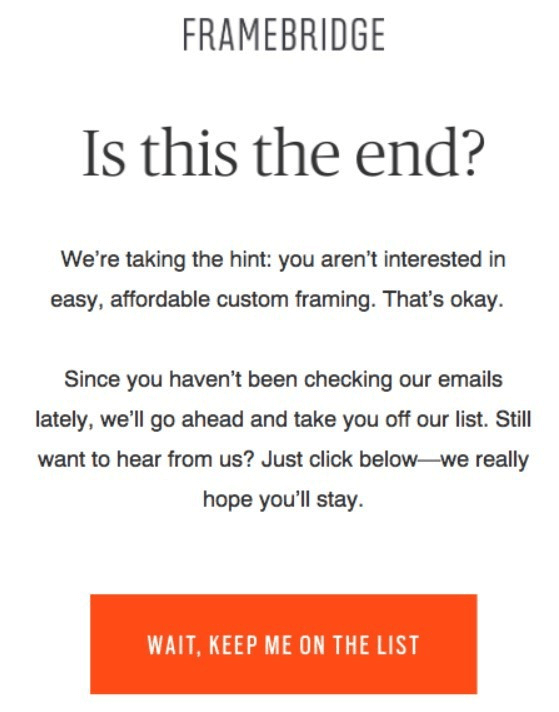
This winback email example illustrates an effective unsubscribe warning that allows readers to opt back in. It’s primarily aimed at list cleanup, so it doesn’t contain the overt sales messaging you would expect earlier in a winback email campaign.
This message only includes a few sentences since disengaged users spend less time reading emails. While all email content should be as concise as possible, this is especially important near the end of your re-engagement series.
Unfortunately, the message doesn’t tell recipients when they’ll be unsubscribed. Try to include a clear time frame so that readers know how much time they have to opt back into your newsletter.
5. Animoto
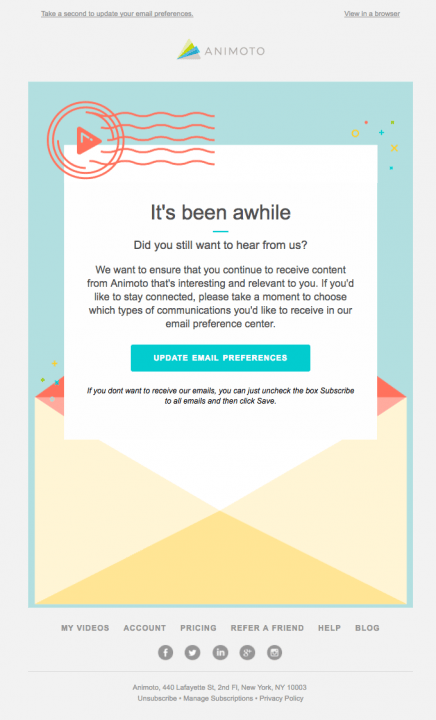
This message from the video creation app Animoto is another good example of a winback email. It immediately points out that it’s been too long since the recipient last engaged with the brand and asks the all-important question directly: Do you still want to hear from us?
At a glance, customers who receive this email know immediately what it’s for. Additionally, the prominent button with a straightforward call to action makes it easy for them to respond. If this doesn’t work to win back customers, it will at least help clean up your subscriber list.
6. Grammarly
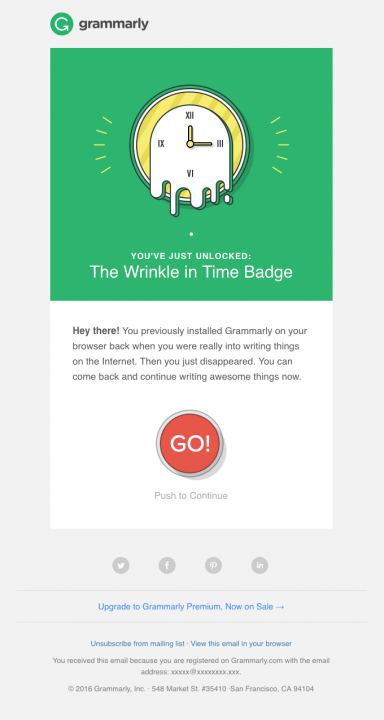
This one by Grammarly is an excellent winback email example. Not only is it straightforward and concise but it also introduces digital badges. These can be a useful tool to boost engagement among digital audiences. Additionally, the badge awarded in the email is a reference to popular literature. As a result, it should resonate with the company’s audience of writers.
Although this email doesn’t offer any incentives to re-engage their users, it reminds its recipients of a time when the tool probably helped them. It also provides an easy way to try the tool again. Plus, it casually mentions that the premium version of their app is currently on sale. This further improves the likelihood of conversion.
7. MTHK

This winback email example from MTHK has a simple design and minimal text, making it easily scannable.
Rather than offering a discount or freebie, this email builds an emotional connection with the recipient by indicating they were missed. The phrase “no more sore eyes” reminds them of the benefits of using MTHK’s products.
The customer testimonial and the five-star rating at the end provide social proof. This builds brand credibility and encourages the inactive customer to buy again.
Additionally, note how the terms “Look again” and “See anything you like?” are a play on words, highlighting that the email is from an eye clinic.
8. Duolingo

The opening line in this customer winback email example from Duolingo aims to create a sense of FOMO. It states that even though they have stopped using Duolingo, others are still learning.
This is one of the customer winback email examples that don’t offer an incentive but provide information on the customer’s lost progress before offering a way to recover it. This encourages users to keep up with their learning streaks.
The email emphasizes that the app can help users learn as much as half a semester’s worth of university-level Japanese in just 30 days. Presenting this value proposition piques the user’s interest and boosts re-engagement.
The winback email clearly states how long it’ll take to get back on track. This is an effective strategy because disengaged customers may feel discouraged from resuming their lessons if they have to start from scratch.
9. Google
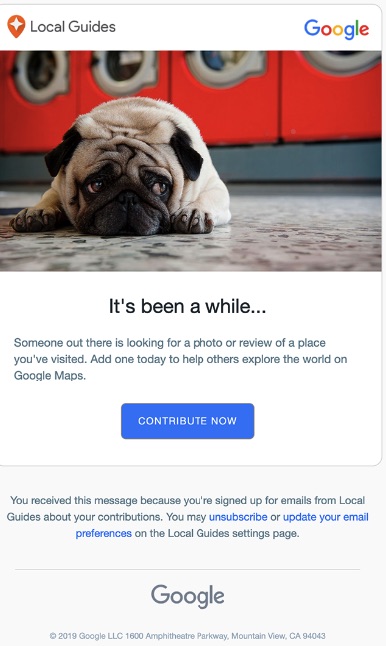
Google’s winback email is simple and to the point, hinting that the user’s reviews may benefit others. It indirectly plays on their emotions to nudge them into action.
Helping other users can serve as a motive for the user to resume their contributions.
A centrally placed CTA also makes it easy to take action, as it directs the user to submit their review.
10. Resy

This email from Resy is another great winback email example. It uses a simple design to keep the focus on the text. It presents a problem and a solution — an effective way to bring disengaged customers up to date with all they must’ve missed.
The design has contrasting colors to draw attention to the CTAs. There are three CTAs that direct customers to different actions based on the information they would like to acquire.
Best practices for winback emails
Every campaign has room for improvement. Top marketers constantly experiment with new strategies to differentiate their brands from the competition. This section will cover a few of the most effective ways to optimize your winback strategy.
Audience segmentation
Audience segmentation is crucial to virtually every campaign and highly effective for re-engagement. Segmenting your email list gives you more in-depth control over your strategies. It also helps you provide more relevant content to each subscriber.
Just as each business has its own definition of an inactive lead, no two customers are exactly alike. Someone who typically makes a purchase every week should be targeted sooner than someone who occasionally visits your website. Similarly, your most loyal customers are worth pursuing for longer than those who have only made one or two purchases.
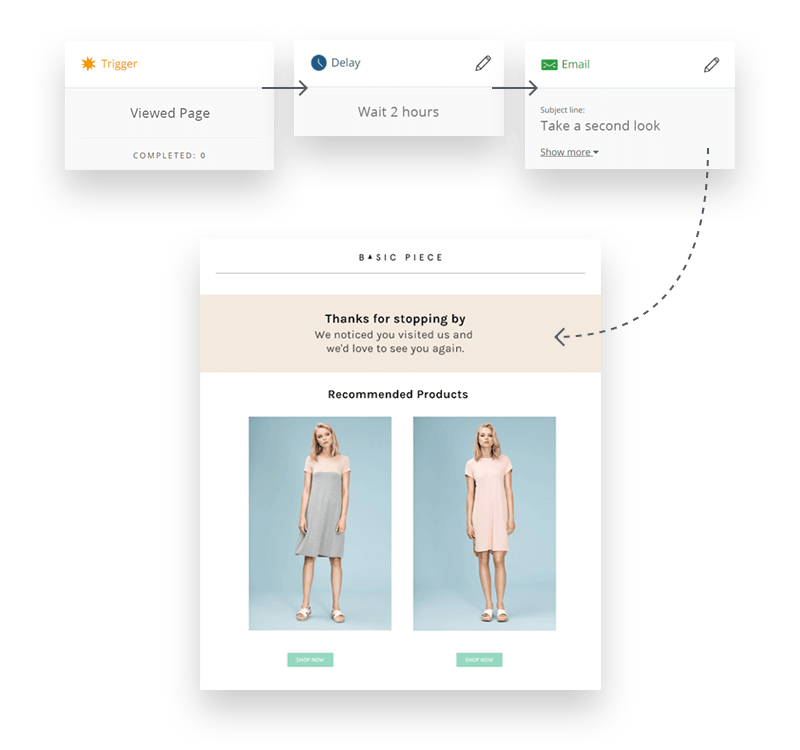
Personalization
Personalizing your winback emails is a great way to recover lapsed customers. Good personalization should meet the needs of your customers, give them good recommendations, and activate them at the right moment. The great thing about it is that personalization isn’t one-sided — it benefits both you and your customer.
To take maximum advantage of personalized winback emails, you’ll need to get an ecommerce personalization software like Omnisend. Essentially, it lets you use marketing automation — triggered messages that go out when a customer has been inactive for a certain period, making your winback emails much more targeted and personal.
Strong subject lines
The subject line is the first thing readers see when scrolling through their inboxes, and a great subject line can help you achieve a substantially better open rate. It’s arguably the most important element to consider when developing a winback email campaign.
Every subject line should get straight to the point and convince subscribers to open the email and learn more. It needs to stand out from the rest of the messages in their inbox and create a sense of urgency.
Try to edit your winback email subject lines down to 40 characters or fewer.
If the winback email includes a discount or other exclusive offer, make sure to clearly communicate this in the subject line. You can also add personalization by including the recipient’s name or addressing them directly — readers are much more likely to respond to targeted content.
Omnichannel engagement
Some users will lose interest in your content, but others simply don’t want to engage with you via email. Subscribers are interacting with brands on more channels than ever, so it’s vital to provide a cohesive experience across multiple platforms. This is particularly relevant given that most inboxes are already overcrowded.
Instead of expecting readers to match your marketing practices, give them the option to engage with you on their terms. Businesses of all sizes should try to build a consistent web presence across as many channels as possible.
Start by performing customer research to determine the right platforms for your unique audience. Apart from having a website and offering email newsletters, you’ll probably want to consider SMS, push notifications, and social media.
A/B testing
Even the best online marketers can’t always predict which strategies will be successful, and A/B testing allows you to identify your most effective tactics. Split tests should be a consistent part of your approach to digital marketing across all types of campaigns.
Winback email subject lines are a perfect place to start split testing. They’re closely tied to your open rate, so stronger subject lines will almost always lead to better results. Increasing the open rate puts your emails in front of more readers and gives you more chances to bring them back to your brand.
Why do subscribers stop opening emails?
We all want to keep subscribers engaged, but some readers will inevitably lose interest in content you send over time. Understanding why your audience stops reading your messages will help you develop a more relevant winback email campaign and bring more customers back to your brand.
Frequency
Most users already receive more emails than they have time to read, and sending too often is one of the most common reasons why subscribers start to ignore newsletters. On the other hand, if you don’t send frequently enough (or consistently), it can have a similar effect.
You can optimize email frequency by performing a few tests or asking subscribers how often they’d like to hear from you when they sign up.
Relevance
Users may also stop opening emails if they feel your content is irrelevant. Every message you send should contain a unique value and offer a sense of urgency that makes readers want to learn more.
Fortunately, contemporary email marketing tools make it easier than ever to create relevant content that’s personalized for each subscriber, improving customer conversion. Email marketing automation may sound generic, but it offers all the tools you need to build emails based on customer data.
As with email frequency, you can always ask new subscribers which types of content they’re interested in and how often you should send them. This gives readers more control over the emails they receive and helps you keep them engaged with more relevant messaging.
Deliverability
Some users will scroll past your emails, but others may not see them at all. Spam filters are more sophisticated than ever, and your messages may be filtered out before reaching the recipient’s inbox. Deliverability refers to the percentage of emails that make it through spam filters to the target inbox.
Filters can trigger for a variety of reasons, including poor engagement, inactive recipient addresses, and a lack of permission to contact subscribers. While you should do everything you can to win back disengaged users, deleting inactive subscribers from your list will increase the rates for both deliveries and opens.
Developing a winback email campaign
The ideal winback email campaign responds to customer concerns and gives readers a reason to re-engage with your content. You should target inactive customers with a sequence of several messages before deleting them from your list.
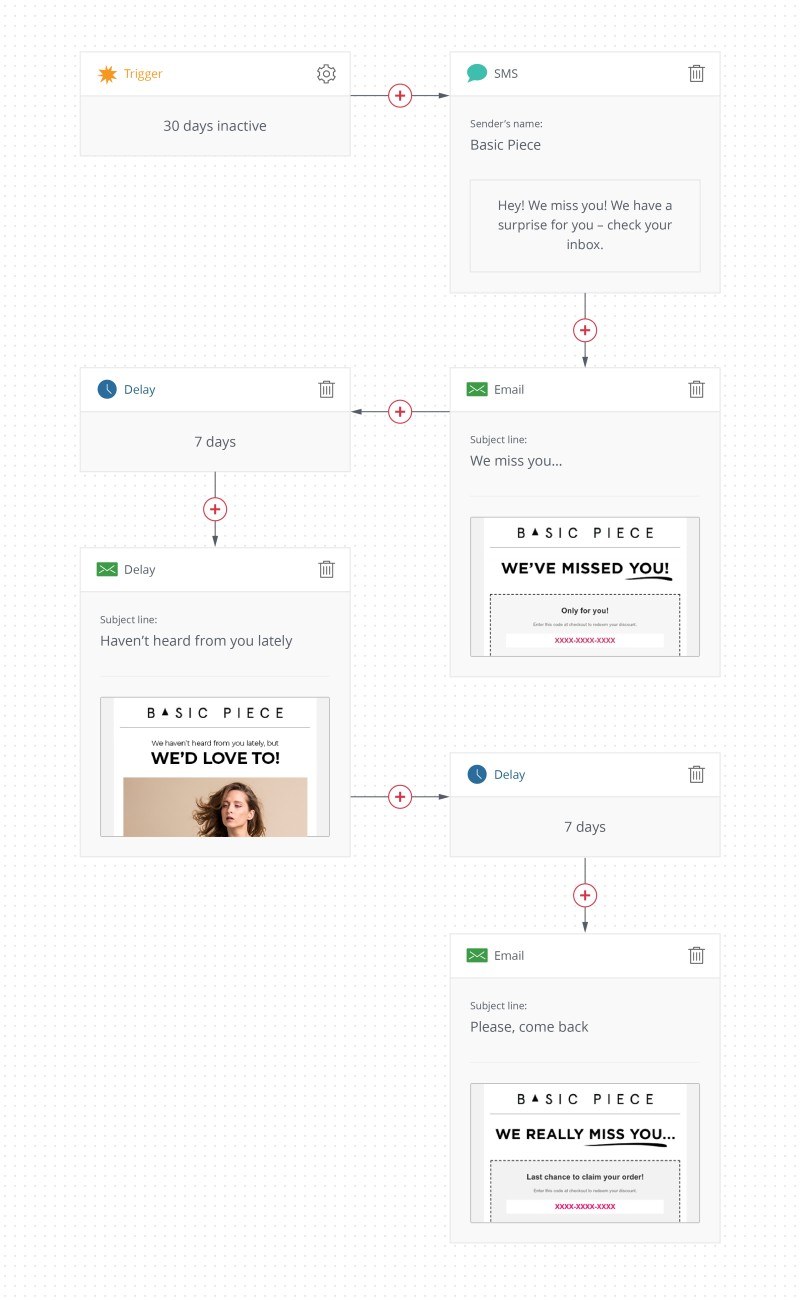
First steps
The first email in your winback email series should contain basic information about your brand along with some reasons to re-engage. You can also take this opportunity to highlight any changes or adjustments you’ve made in the last several months.
Readers who usually ignore your content probably don’t want to spend much time reading them, so try to make them as concise as possible. This message should only include the most relevant information and be easy to skim through in just a few seconds.
Providing motivation
After this reminder, the next step is to give subscribers an additional incentive to come back. Exclusive offers are often enough to win them over, and they’re a small price to pay for an ongoing customer.
Your incentive could be anything from a discount to free shipping or rewards points, as long as it’s enough to give readers fear of missing out. It’s better to re-engage customers without an offer whenever possible, so this winback email shouldn’t be the first item in your series.
Keep in mind that conversion is more likely to happen when you give customers exclusive incentives that create a sense of urgency. Limited times and quantities, for example, make subscribers feel like they need to act now to benefit from the offer.
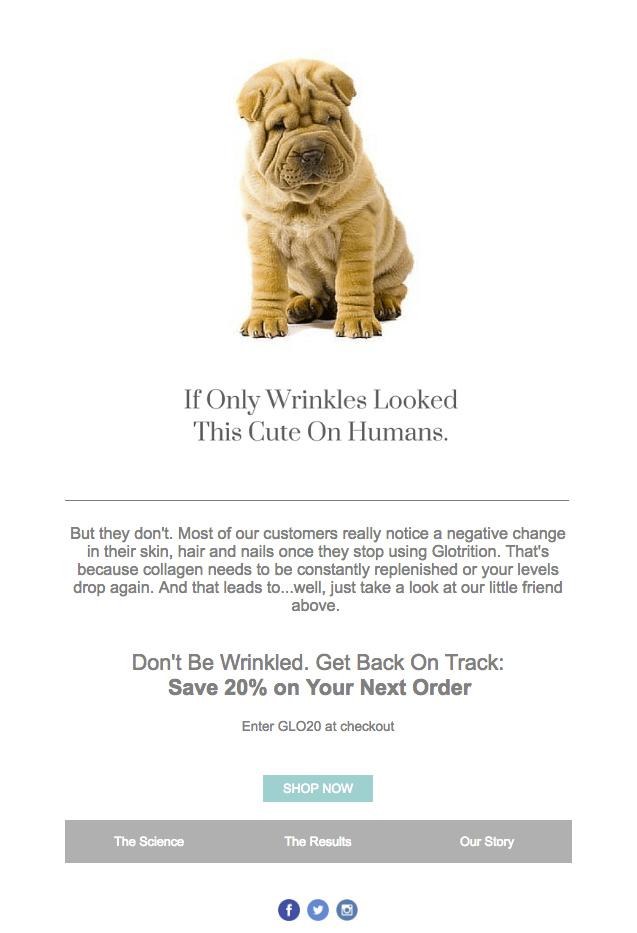
Gathering customer data
Customers want to feel like they have a voice, and audience feedback can be incredibly valuable. Asking readers what you could improve is one of the most effective ways to identify weaknesses in your customer relationships.
Without gathering feedback, you won’t be able to learn what’s driving your readers away. This winback email also demonstrates that you take customer satisfaction seriously.
As with other emails in the winback series, you can generate better open and response rates by offering an incentive. That said, this message should be primarily focused on feedback rather than sales.
Preparing to unsubscribe
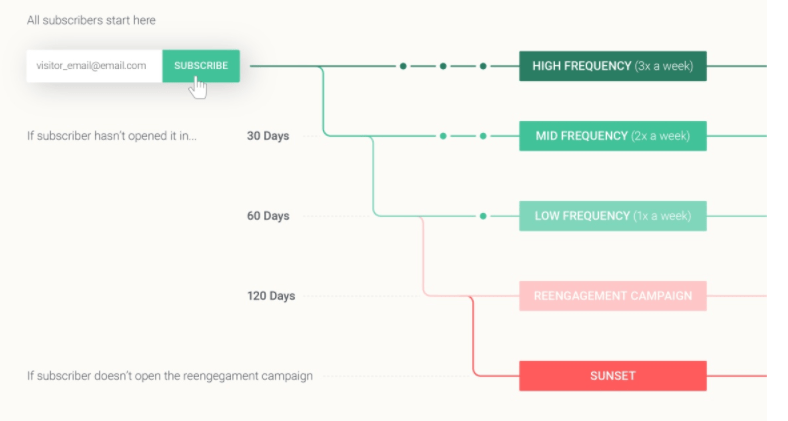
After three attempts, it’s time to start the unsubscribe sequence. Keeping inactive customers on your list can hurt both engagement and deliverability. The fourth message lets users know they’ll be unsubscribed unless they ask to continue receiving emails.
A few readers may reconsider, so give them a week or two to rejoin your email list. That said, it’s better to have users opt back in rather than letting them opt out since some won’t open the message.
While you can include a reminder of your newsletter’s benefits, this winback email should be kept as short as possible. This is your last chance to win back users who have stopped opening or clicking through on your emails, so it needs to be one of your top priorities.
Unsubscribe confirmation
Unfortunately, some users won’t respond to any email in your winback campaign series. At this point, all you can do is let them know that they’ve been taken off your email list. Some readers may come back after seeing this email, but it shouldn’t contain any promotional materials.
It can be tempting to continue sending emails to re-engage inactive users, but this does more harm than good by reducing the quality of your email list. If users are still disengaged at the end of your sequence, they should be automatically unsubscribed.
Conclusion
Winback emails are great for rekindling a lost customer’s interest in your brand and encouraging them to continue engaging with your content. They also serve as a great way to clean up your email list, helping you identify customers who can’t be recovered.
By implementing the tips and strategies mentioned in this guide, you can craft more targeted winback email campaigns that maximize customer lifetime value.
Source from Omnisend
Disclaimer: The information set forth above is provided by omnisend.com independently of Alibaba.com. Alibaba.com makes no representation and warranties as to the quality and reliability of the seller and products.

